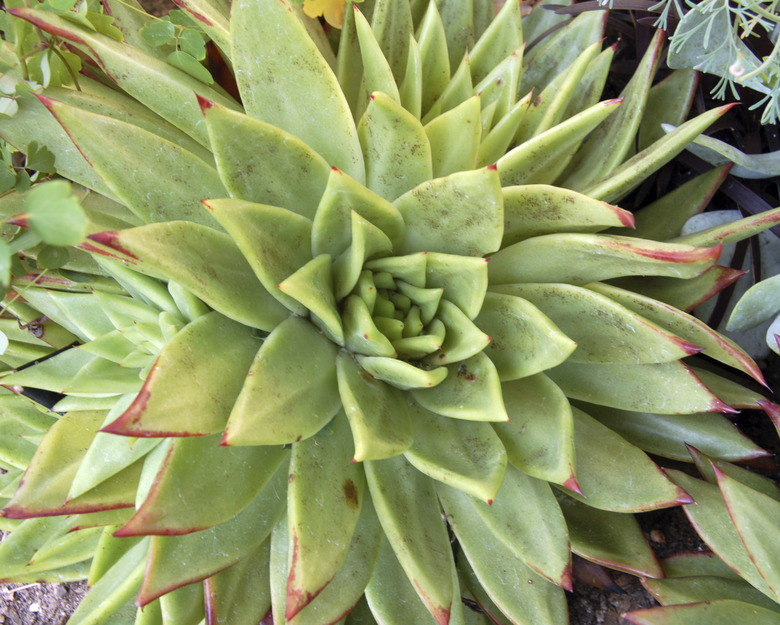How To Care For A Hens & Chicks Plant
Hen[ [chicks ]](https://www.gardenguides.com/12521502-how-can-i-root-clippings-from-a-hens-chicks-plant.html) and chicks plant (Sempervivum tectorum) is named for the rosette, or hen, and small offsets, or chicks, that grow on slender runners extending from the succulent. This sturdy plant thrives in tough growing conditions and needs only a thin layer of soil to develop roots. After the hen flowers and sets seed in summer, it dies back and the chicks fill in the empty spot. Hens and chicks grows outdoors in U.S. Department of Agriculture plant hardiness zones 3 through 8. Sometimes called houseleek, you can also grow hens and chicks as a houseplant.
Outdoor Care
Like most succulents, hens and chicks thrive in poor, sandy, well-draining soil and full sun. A spot where the plant gets afternoon shade is best in hot, sunny climates, but too much shade may result in a spindly, pale plant. To plant hens and chicks, loosen the top of the soil with a spade or garden fork, then nestle the plant into the top of the soil. It will soon develop roots that anchor the plant to the soil. Water to a depth of 6 to 8 inches after planting. After that, water only when the soil is dry — usually every seven to 10 day during hot weather. The plant doesn't need any fertilizer. To keep hens and chicks neat, pinch off flower heads after the plant blooms in midsummer.
Houseplant Hens and Chicks
Hens and chicks performs best and shows its best colors outdoors, but with proper care and a container with drainage holes, you can grow this succulent plant indoors. Plant hens and chicks in a container filled with a mixture of equal parts potting mix and sand, then place the plant in a south-facing window where it gets at least six to eight hours of sun each day. If you don't have a sunny window, place the plant under grow lights or fluorescent bulbs for 14 to 16 hours per day. Allow 6 to 12 inches between the plant and the bulb. Proper watering is critical because succulent plants rot quickly in soggy, waterlogged soil. One watering per week is generally enough during warm weather, but never water the plant unless the soil feels completely dry. Water sparingly during the winter, providing only enough water to keep the plant from shriveling. Let the pot drain thoroughly and never let the plant stand in water.
Making More Hens and Chicks
Hens and chicks is easy to propagate by removing chicks from the hen any time or year. This usually happens because the plant outgrows its garden spot or container or because the hens and chicks are too crowded. Allow the chick to develop until the runner dies back and you can see small roots at the base of the chick. Cut or break the chick from the hen and plant it in a pot filled with a sandy potting soil mix, or in well-drained outdoor spot. To keep from transferring disease to the plant while pruning, wipe the blades of your tools with alcohol and allow to dry before using.
Considerations
Although hens and chicks can spread up to 2 feet wide, they are not considered an invasive plant. Hens and chicks are generally disease-free with the exception of root or stem rot or rust, which occur if hens and chicks are overwatered or placed in soil that doesn't drain well.
References
- Missouri Botanical Garden: Sempervivum Tectorum
- The Houseplant Encyclopedia; Ingrid Jantra, Ursula Kruger
- North Dakota State University Extension: Hens and Chicks: Planting Instructions
- North Dakota State University Extension: Succulents and Cacti
- The New Western Sunset Garden Book; Kathleen Norris Brenzel, Editor
- University of Wisconsin Health: Common Plants: What's Poisonous and What's Not?
- The Gardener's A-Z Guide to Growing Flowers From Seed to Bloom; Eileen Powell
